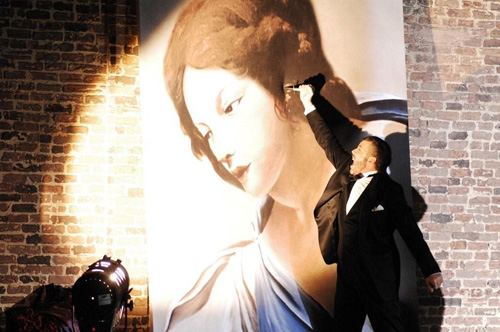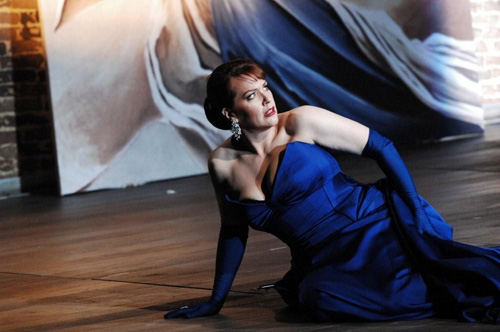 Switzerland Puccini, Tosca: Soloists,Chorus of the Zurich Opera, Philharmonia Zurich, conductor:Marco Amiliato, Zurich Opera, Zurich. 18.12.2012. (JR)
Switzerland Puccini, Tosca: Soloists,Chorus of the Zurich Opera, Philharmonia Zurich, conductor:Marco Amiliato, Zurich Opera, Zurich. 18.12.2012. (JR)
Cast:
Tosca: Catherine Naglestad
Cavaradossi: Massimo Giordano
Scarpia: Thomas Hampson
Angelotti: Valeriy Murga
Sacristan: Dimitri Pkhaladze
Spoletta: Peter Straka
Sciarrone: Erik Anstine
Shepherd: Natalie Hug
Production:
Director: Robert Carsen
Sets: Anthony Ward
Lighting: Davy Cunningham
Chorus: Ernst Raffelsberger

Canadian opera director Robert Carsen first brought his Tosca to Zurich in 2009 when Jonas Kaufmann sang Cavaradossi and Emily Magee was his Tosca. Thomas Hampson sang the role of Baron Scarpia. A few years later the Zurich opera has revived the production, with Catherine Naglestad as Tosca and Massimo Giordano as Cavaradossi.
Carsen gets rid of the church in Act I, Palazzo Farnese in Act II and Castel Sant Angelo in Act III and places the action in just one location, a theatre (or possibly an opera) stage. And it is apt as we are reminded at several places in the libretto that Floria Tosca is a renowned singer and actress. Modernising the opera works well, though removing all visual references to Rome works less well. Act I brings us not the rows of seating in a church but the auditorium of a theatre, with a scarlet and gold curtain at the back. Quite what Cavaradossi is doing there, painting a Renaissance picture of Countess Attavanti on the wall of the theatre, remains a mystery. The Sacristan has been transformed into a caretaker. Act II is backstage, with a brick wall and a safety curtain, Tosca signing autographs. Scarpia sits at an antique desk and his dinner is brought by Covent Garden-lookalike liveried flunkeys. Act III is then on the bare theatre stage itself instead of the parapet of Castel Sant Angelo.
One should not think too deeply why there is a shepherd, hauntingly sung in this performance by Natalie Hug, in the auditorium nor why one hears so many church bells before Cavaradossi is shot. Perhaps they are just outside the theatre.
Anyhow, musically this is a very fine Tosca. Naglestad and Giordano have been singing these roles around the world for the last few years, and are certainly considered top casting. They make a well matched pair, both visually and sonically. Their duet is completely together. Naglestad impresses both for her acting and her voice; she certainly looks and sounds the part. Top notes are thrilling, lower registers suit her voice particularly well, though I lost attention towards the end of “Vissi d’arte”, perhaps her Italian diction not quite Italianate enough. Giordano hits all the notes including those of “Vittoria” but showily he held onto one top note for far too long: it did not bring the rapturous applause he hoped for. I did find his voice rather characterless.

Hampson is, of course, the consummate musician and has a beautiful voice. That’s his problem as Scarpia, he does not look mean enough to be a torturer and scoundrel, despite his visual grimaces and despite the producers trying to make him look like Bela Lugosi, he is just too slick. Cleverly, in Act II, he lubricated his voice before almost each line with a sip of Ribena. In this production Tosca would seem to do well to drop Mario and tie up with debonair, suave Hampson.
Marco Armiliato, best known in America for Italian opera, put plenty of energy into the drama and the orchestra responded well. A particular plaudit must go the principal clarinettist for her beautiful solo in Act III.
At the end, Tosca hurls herself off the stage into a dark auditorium and the stage lights dazzle to signify the end of the show. A good show it was, if not a great one.
John Rhodes